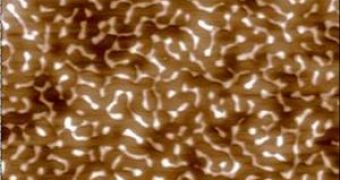The so-called "nonpolymerizable" 1,2 disubstituted ethylenes have been turned to polymers.
This is the result of the work of two motivated UD chemists: Chris Snively and Jochen Lauterbach.
The new class of ultra-thin polymer films has potential for coating from tiny microelectronic devices to plastic solar cells. Ethylenes can be found in some natural sources, such as cinnamon, and are FDA-approved for use in fragrances and foods, but one of the compounds is also found in milkshakes. "There's been a rule that these molecules wouldn't polymerize," Snively noted.
In polymerization, small identical (or not) molecules called monomers, join together to form a long chain-like molecule, named polymer. Each polymer is made of 1,000 or more monomer molecules. There are many natural polymers, from the DNA to chewing gum, starches, or cellulose. Plastics, of course, are one of the most common artificial polymers, discovered in 1850's and found today in a wide array of applications, from cups, carpet fibers, epoxy to PVC pipes.
Since 1998, the two chemists have been searching for a method to make extremely thin polymer covering layers. These nanofilms - more than 1,000 times thinner than a human hair - are increasingly important as coatings for sophisticated vulnerable devices (optics, solar cells, electrical insulators, advanced sensors and others).
Classic polymerization is done by exposing a monomer mixed with a solvent to heat or light. But the new polymer-making technique eliminates the solvent from the equation. The deposition-polymerization (DP) process is made in a vacuum chamber, where the air is eliminated and the pressure is similar to outer space.
If we want to coat a piece of metal, it is placed in the chamber cooled below the monomer's freezing point, which provokes the deposit of the monomer vapor on the metal and ultraviolet light the film turns into a polymer.
The film is uniform, defect-free, with thicknesses that can be adjusted to within millionths of a mm. "The process is fairly "green," in that not only are no solvents used, but there also is very low energy consumption using this method," said Lauterbach.
"You also can do photolithography with it," he added; "the polymer will form only where the light hits the monomer film. We can make nanometer-thick films, but we can't make a gram of the material yet," Snively noted. "We're working on ways to scale up the process."
The material's properties have not been investigated yet. "We're kind of in the discovery phase, looking to see where all these materials could be used", said Lauterbach.
The new class of polymers may be applied soon to plastic solar cells through collaborative research in the new Sustainable Energy from Solar Hydrogen program.

 14 DAY TRIAL //
14 DAY TRIAL //